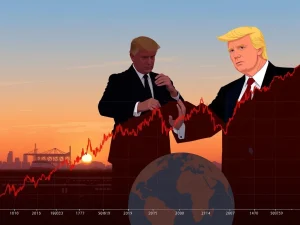Bitcoin Miner Accumulation: Is an Explosive BTC Price Rally Imminent?

Bitcoin miner accumulation has reached levels not seen since late 2023. This pattern historically fueled significant price rallies. The cryptocurrency community now watches intently. Many wonder if new Bitcoin (BTC) highs are next. This renewed interest comes as market indicators suggest strong underlying demand. Investors are closely monitoring these developments, anticipating potential shifts in the BTC price.
Bitcoin Miner Accumulation Signals Potential BTC Price Surge
Miners are key players in the Bitcoin ecosystem. Their actions often reflect market sentiment. Recent data reveals a significant trend. Bitcoin miners are accumulating BTC at a pace unseen since October 2023. This mirrors a period that preceded a substantial 48% rally. Glassnode data shows miners’ wallets have added positions for three consecutive weeks. Net inflows peaked at 573 BTC per day on Tuesday. This level represents the highest accumulation since late October last year.
Such strong Bitcoin miner accumulation typically signals bullish expectations. Miners, who incur significant operational costs, usually sell BTC to cover expenses. When they hold onto their newly minted coins, it suggests confidence. They anticipate higher future prices. This reduced selling pressure from miners can directly impact the BTC price. It helps push prices upward. The previous accumulation phase in 2023 led to a remarkable price surge. This history prompts traders to consider a similar trajectory. Could BTC indeed reach $150,000?
Corporate Giants Bolster Bitcoin Holdings, Including MicroStrategy
Beyond individual miners, corporate entities continue to strengthen their Bitcoin positions. This trend provides further support for the market. Companies like MicroStrategy (MSTR) remain prominent buyers. Metaplanet (MTPLF) and Cango Inc. (CANG) also actively acquire BTC. These corporate purchases demonstrate increasing institutional adoption. They signal long-term confidence in Bitcoin’s value.
MicroStrategy, a leading business intelligence firm, recently disclosed another significant purchase. The company added $220 million worth of Bitcoin. This move came despite missing potential inclusion in the S&P 500 index. Michael Saylor’s firm now holds a market capitalization of $95 billion. This places it among the largest listed companies in the United States. Its reserves contribute substantially to overall corporate Bitcoin holdings. BitcoinTreasuries.NET data confirms this growing trend. Reserves held by the top-100 public companies exceeded 1 million BTC for the first time in September. This milestone highlights the increasing corporate appetite for Bitcoin.
Bitcoin ETFs Drive Unprecedented Inflows and Market Penetration
The emergence of US-listed spot Bitcoin ETFs has dramatically reshaped the investment landscape. These funds provide a regulated and accessible pathway for traditional investors. They allow participation in the Bitcoin market. Recent performance underscores their impact. Spot Bitcoin ETFs attracted an impressive $1.3 billion in inflows between Wednesday and Thursday. This influx pushed their total assets under management (AUM) to $148 billion.
The iShares Bitcoin Trust (IBIT) leads the pack. It commands $87.5 billion in AUM. Fidelity Wise Origin Bitcoin Fund (FBTC) follows with $23 billion. Grayscale Bitcoin Trust (GBTC) holds $20.6 billion. These figures are significant. For context, gold ETFs represent the largest tradable asset class. They hold $431 billion. The broader gold market is valued at $24.7 trillion. Despite being launched only in 2024, Bitcoin’s ETF industry shows deeper penetration. This is relative to its $2.3 trillion market capitalization. This rapid growth indicates robust investor demand. It also suggests a growing acceptance of Bitcoin as a legitimate asset class.
Macroeconomic Risks Temper BTC Price Optimism
While bullish signals abound, the path to new BTC price highs faces potential headwinds. Macroeconomic risks present a significant challenge. Investors are currently pricing in a 75% chance of US interest rates falling. They anticipate rates reaching 3.5% or lower by the end of 2025. However, recent economic indicators introduce caution. The University of Michigan’s consumer sentiment survey revealed a decline. Confidence dropped more than expected in September.
Furthermore, long-run inflation expectations climbed to 3.9%. Concerns over tariff impacts fueled these rising expectations. Such economic uncertainties can dampen investor enthusiasm. A weakening consumer sentiment often precedes slower economic growth. This could lead traders to adopt a more cautious approach. Despite the strong accumulation from miners and corporations, these broader economic factors cannot be ignored. They could cap Bitcoin’s potential gains. Therefore, the market remains in a delicate balance.
The Outlook for Bitcoin: Navigating Macroeconomic Risks for New BTC Price Highs
The confluence of strong Bitcoin miner accumulation and institutional interest paints a compelling picture. This bullish sentiment is further amplified by robust Bitcoin ETFs inflows. Many analysts predict a significant move for the BTC price. Some speculate on a push towards $140,000 or even $150,000. However, the prevailing macroeconomic risks introduce an element of unpredictability.
Key factors influencing Bitcoin’s near-term trajectory include:
- Federal Reserve Policy: Future interest rate decisions will heavily impact market liquidity.
- Inflation Trends: Persistent inflation could either boost Bitcoin as a hedge or lead to tighter monetary policy.
- Consumer Confidence: A decline in consumer spending can signal broader economic weakness, affecting risk assets.
- Corporate Demand: Continued acquisitions from entities like MicroStrategy provide a fundamental demand floor.
The market stands at a crucial juncture. While historical patterns suggest a rally, current economic uncertainties demand careful consideration. Investors will closely watch upcoming economic data releases. They will also monitor central bank communications. These elements will likely determine Bitcoin’s next major move. The interplay between strong internal market dynamics and external economic pressures will define the coming weeks.
Bitcoin’s market shows strong internal bullish signals. Miner accumulation and corporate buying are robust. Bitcoin ETFs continue to attract substantial capital. These factors create a strong foundation for potential BTC price appreciation. Nevertheless, persistent macroeconomic risks introduce caution. Investors must weigh these opposing forces carefully. The path to new highs, while promising, remains complex.







